The blast sounded from a compound in the early hours. Several floors up, shattered windows marked the Tehran guesthouse where Hamas political chief Ismail Haniyeh, in town for the inauguration of Iran’s new president, was dead along with a bodyguard. Iran claimed it was an Israeli missile but Middle Eastern officials let slip to reporters that a bomb had been planted two months earlier, which operatives had waited to detonate from afar on July 31. Iran and Hamas vowed to avenge Haniyeh’s killing.
Israel, which has not confirmed its forces were responsible, is bracing for an imminent attack. Meanwhile, tensions are ratcheting up again in the Red Sea, where Yemen’s Houthi rebels have resumed attacks on ships after a two-week pause. Israel has blamed Hezbollah in Lebanon for a rocket that killed 12 children at a soccer field in late July, and has retaliated with an air strike on Beirut that killed a senior Hezbollah commander. Hezbollah has promised its own “strong” retaliation, stoking fears of an escalation beyond the daily rocket exchanges on the Lebanon-Israel border.
Ten months after Hamas’ attacks, and Israel’s subsequent offensive in Gaza, the consequences are cascading. “Almost everything that happens in the Middle East has an effect on something else somewhere,” says Ian Parmeter, an ANU research scholar at the Centre for Arab and Islamic Studies. “The common denominator is Israel: either various countries making accommodations with Israel as they might see fit to assist them in their broader foreign policy goal, or other states or sub-state actors resolutely opposing Israel.”
A miscalculation by any of the groups involved could ignite a bigger conflict that, at its worst, could engulf the region.
It’s a situation where entangled motives and historic disagreements make outcomes of conflicts difficult to assess, says Parmeter. Ceasefire talks between Israel and Hamas, including in recent days in Qatar, offer a slim chance of defusing hostilities. Still, “the Middle East is a very difficult area to make forecasts on simply because we don’t know the internal machinations in a number of the countries”.
So who are the main players in the Middle East? How do their allegiances, alliances and so-called proxies work? And what could happen next?
Iran’s leader, the Ayatollah Ali Khamenei, centre, leads a prayer over the coffin of Hamas leader Ismail Haniyeh, killed by a bomb in Tehran in July.Credit: Office of the Iranian Supreme Leader, via AP
Who are the major players in the Middle East?
“Something distinctive about the Middle East is that there really aren’t alliances in the sense that there are in North-east Asia and Europe – but there are groupings,” says Ben Scott, a former Australian representative to the Palestinian Authority and diplomat in Israel. The Middle East, between Asia, Europe and Africa, is a crossroads by land and sea that contains about half the world’s oil reserves. It has a long history of major actors rising to and receding from power in a shifting array of tensions.
Major conflicts include the Suez Crisis in Egypt (1956), Lebanon’s civil war (1975 to 1990), the Iraq War (2003 to 2011) and the Syrian civil war (since 2011). Today the focus is on Israel’s war in Gaza, where some 40,000 Palestinians have lost their lives, according to the Hamas-run health ministry, 1.9 million people are displaced and much of the built landscape is in ruins. Millions of people in Syria and Yemen are also in peril after years of civil war in those nations. The legacies of other conflicts as well as current crises remain a fact of life in various other countries in the region (more on which later).
Helping to shape political allegiances in the region are the different versions of the Islamic faith. Sunnis are the largest branch, making up most of the world’s Muslims, including those in Saudi Arabia, where a strict branch of Sunnism known by outsiders as Wahhabism is practised. Shiite Islam is the second-largest, currently dominant in Iran and Iraq. Sunni and Shiite Muslims diverged in the 7th century CE after a disagreement over who could rightly succeed the Prophet Muhammad as leader.
It was in 1979 that he coined his memorable catchphrase: ‘[America is] the great Satan, the wounded snake.’
Both Sunni Saudi Arabia and Shiite Iran have exploited the sectarian divide to further their ambitions, writes the Council on Foreign Relations, an independent US think tank. They are often on opposite sides in conflicts. “How their rivalry is settled will likely shape the political balance between Sunnis and Shiites and the future of the region, especially in Syria, Iraq, Lebanon, Bahrain and Yemen.”
Outside of Gaza, the tension that looms largest in the region is between Iran and Israel. Until the late 1970s, when Iran was ruled by the monarchy of the Shah, its relations with Israel, a Jewish state formed in 1948, were often co-operative. That all changed in 1979 when radical cleric Ayatollah Ruhollah Khomeini overthrew the West-leaning government and began his rule as leader of the Islamic Republic, a Shiite theocracy.
At the time, most Arab countries did not recognise Israel (although Egypt was on the verge of signing a peace treaty with it). Khomeini vehemently opposed Israel and began championing the Palestinian cause. He would go on to give clergy executive power over government policy, mandate that women wear hijab and ban Western music, movies and alcohol. It was in 1979 that he coined his memorable catchphrase: “[America is] the great Satan, the wounded snake.”
In the decades since, Iranian leaders have called for the abolition of the Israeli state. Israel today sees Iran as an existential threat, a situation exacerbated by Iran’s funding of militant groups on Israel’s doorstep and its prospects of developing viable nuclear weapons (it denies running such a program but has enriched enough uranium to make several nuclear weapons, according to the International Atomic Energy Agency).
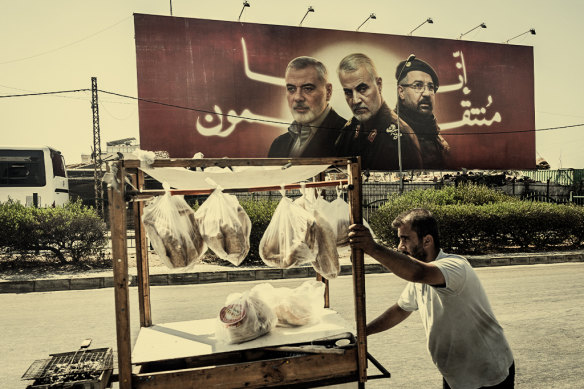
In Lebanon’s capital Beirut, a food cart vendor passes a billboard showing assassinated leaders Hamas’s Ismail Haniyeh, General Qasem Soleimani of the Iranian Revolutionary Guard and Hezbollah commander Fuad Shukr.Credit: Getty Images, digitally tinted
Iran’s belligerence can be at least partly explained by being a Persian-speaking, Shiite state with neighbours across the Gulf – not only the Saudis but the United Arab Emirates, Kuwait, Qatar, Oman and Bahrain – speaking Arabic and being largely Sunni (most of Bahrain’s people are Shiite but it is ruled by a Sunni monarch). To the east, Iran borders some of the world’s most volatile regions, including Afghanistan. To the west, Israel – the only state in the region believed to have a nuclear arsenal – is a two-hour plane trip away.
Loading
“To overcome both the Arab-Persian divide and the Sunni-Shiite divide,” Trita Parsi, executive vice-president of the Quincy Institute for Responsible Statecraft, told Al Jazeera in 2023, “Iran adopted a much more aggressive position on the Palestinian issue to brandish its leadership credentials in the Islamic world and to put Arab regimes allied with the United States on the defensive.” Iran is also deeply invested in the affairs of next-door neighbour Iraq, where it backs and maintains numerous militia groups and supports the Shiite parties that form the elected government.
The United States has a long history of exerting (or attempting to exert) its influence in the Middle East, stemming from its role in controlling the region’s oil reserves in colonial times, its wars in Iraq, Kuwait and Afghanistan, and its fractious relationship with Iran, exacerbated by the 1979 Tehran hostage crisis, in which militants held US diplomats hostage for more than a year.
The US’s long-time support for Israel and pro-Western Arab states appears to be a significant deterrent against a wider regional conflict but comes at a significant cost. In January, three US soldiers were killed at a base in Jordan in a drone attack blamed on the Iran-backed, Iraqi-based militia Kataib Hezbollah. In response, the US conducted air strikes on more than 85 targets in the region affiliated with Iran’s Islamic Revolutionary Guard Corps. The US has also sent naval vessels, including an aircraft carrier battle group and cruise missile-equipped submarines, to support Israel against an Iranian-led attack (as occurred in April, when Iran fired missiles and drones into Israel after an Israeli strike on Iran’s embassy in Syria) and to protect shipping in the Red Sea from attacks by the Yemeni rebel group known as the Houthis. And the US has led air strikes against Houthi installations in Yemen.
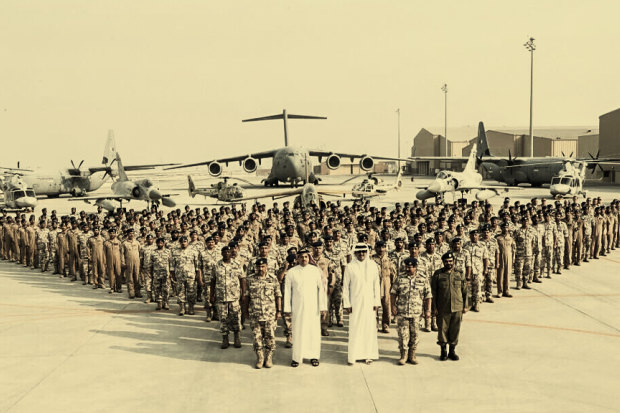
Qatari leaders with soldiers during a visit to Al Udeid Air Base in Doha in 2017.Credit: Getty Images, digitally tinted
US forces also remain a visible presence in northern Syria, where roughly 900 troops operate to prevent a resurgence of Islamic State, and Iraq, where the US maintains air bases after its eight-year occupation. Iraq deals with the US, Parmeter says, “but they’re really not in any sense a reliable ally of the US”.
Bob Bowker, a former Australian diplomat in the Middle East for 37 years, tells us: “You’ve had a winding-back of American influence in the region, I would say, going back to the Obama period.”
‘There is .. a degree of scepticism bordering on contempt towards the United States that was not there 10 years ago.’
Former Australian diplomat Bob Bowker
The upheavals of the Arab Spring in 2011 and 2012 and Washington’s wavering response have created a perception that the US is not as reliable or attuned to the region as it once was. “From the Arab point of view,” says Bowker, “the Americans have never sought to use the power that is at their disposal to put pressure upon Israel to comply with even the Americans’ own wishes and interests. So there is this, I think, a degree of scepticism bordering on contempt towards the United States that was not there 10 years ago. It is there now.”
For its part, Saudi Arabia has recently positioned itself as a peacemaker. Before Hamas killed nearly 1200 people and took hostages from Israeli communities and at a music festival on October 7, the Saudis were on the verge of normalising relations with Israel, which they have not ever formally recognised; the attacks, and Israel’s military response in Gaza, instantly derailed those negotiations.US President Joe Biden claimed this disruption was a prime motivation for Hamas. “One of the reasons Hamas moved on Israel … they knew that I was about to sit down with the Saudis,” Biden said in October 2023. “Guess what? The Saudis wanted to recognise Israel.” Saudi Arabia’s Crown Prince, Mohammed bin Salman, has said Israel making concessions for Palestinians remains a sticking point preventing a peace agreement.
Some Arab states side with Hamas and some don’t, says Parmeter. “There’s a lot of anger in the Arab world at street level over what Israel has been doing in Gaza,” he says, noting at the same time, “Egypt, the Gulf states and Jordan are very anti-Hamas because they essentially see it as being an Islamist extremist organisation.”
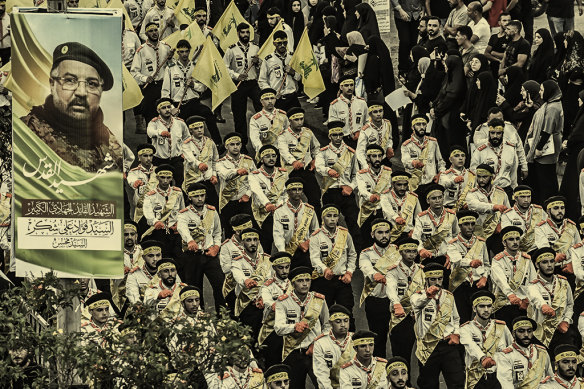
Hezbollah fighters and mourners at the funeral of commander Fuad Shukr, who died in a missile strike on Beirut on July 30.Credit: Getty Images, digitally tinted
In Turkey, President Recep Tayyip Erdogan has praised Hamas as an “organisation of liberation” and refused to follow Australia and other Western nations in designating it as a terrorist group. Yet, according to The New York Times, Turkey also supports a two-state solution to the Israeli-Palestinian conflict and recognises Israel diplomatically.
‘Qatar sees itself as a country where people from a diverse range of interests can congregate.’
Middle East analyst Rodger Shanahan
In Jordan, on Israel’s eastern flank, King Abdullah II is seen to be caught between calls from the populace, many of whom have Palestinian origins, to intervene somehow in the Gaza war, and his nation’s close ties to the US as well as a carefully guarded 30-year peace treaty with Israel.
Egypt, the first Arab country to recognise Israel with a peace treaty in 1979, is today hoping to prevent an influx of Palestinian refugees from Gaza, just across its northern border (Egypt already hosts more than 670,000 refugees, many from previous conflicts in Sudan and Syria).
Qatar, a thumb-shaped emirate on the edge of Saudi Arabia, is hard to read, says Middle East analyst and former army officer Rodger Shanahan. “It has always seen itself as potentially vulnerable, and one of the ways that it provides for itself is it plays many sides at the one time.” Qatar funds Hamas and the group has an office in its capital, Doha. Yet, south-west of the capital, Qatar also allows the US to maintain its largest military base in the Middle East, Al Udeid Air Base. In the Gulf, Qatar shares the world’s biggest natural gas reserve with Iran. “Switzerland is way too different a comparison. But in a kind of bizarre, Gulf way, Qatar sees itself as a country where people from a diverse range of interests can congregate,” says Shanahan.
Meanwhile, across the region, hundreds of millions of Arabic-speaking people share common cause and sympathies, irrespective of their governments’ political manoeuvrings. This is one of the reasons the Arab Spring protests of the early 2010s spread from Tunisia, where they toppled dictator Zine el-Abidine Ben Ali, to Egypt, Syria, Bahrain, Jordan, Kuwait and Oman. Recent mass protests across the region against the war in Gaza have renewed some of those shared sentiments, Abdurrahman Sultan, a 36-year-old Kuwaiti activist, told The New York Times in April. “What’s happening to the Palestinian people clarifies the foundation of the problem for Arabs everywhere, that the problem is tyranny.”
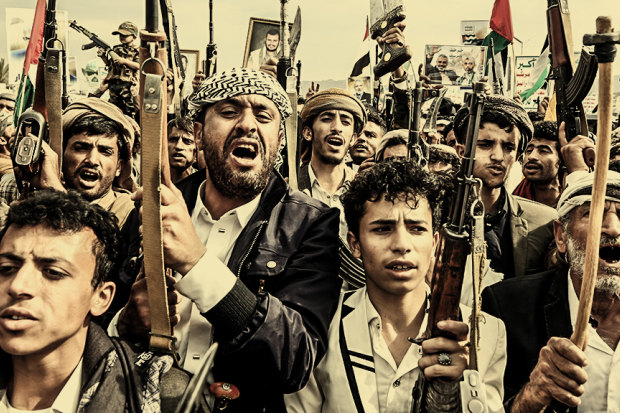
Yemenis with rifles and Houthi emblems show solidarity with Palestinian people on August 9 in the capital, Sanaa. Credit: Getty Images, digitally tinted
What is the Axis of Resistance?
Iran leads the so-called Axis of Resistance, an alliance that includes Bashar al-Assad’s Syrian government and the militant groups Hezbollah (in Lebanon), Hamas (in Gaza), the Houthis (in Yemen) and several smaller pro-Iranian militias in Iraq, including Kataib Hezbollah (but not the Iraqi government). Iran’s Quds Force, part of the Islamic Revolutionary Guard Corps, gives these groups training, weapons and funds. Some of them have dealings with Russia but Parmeter stops short of calling them pro-Russian. “What really gives them their mojo is being anti-American. They’re completely opposed to America’s policies in the region.”
The resistance as a regional force can be traced to the Iranian Revolution, says Bowker, who served as Australia’s ambassador to Jordan, Egypt and Syria. “1979 was an absolute turning point in the regional outlook. The way in which Khomeini came to power and secured his power through what became the Revolutionary Guards set the tone to Iran’s approach to the region. The Revolutionary Guards have continued to dominate the security, regional policy, judicial, media and other elements of the Iranian system. That has, basically, shaped the way Iran has dealt with its neighbourhood and been perceived by its neighbourhood.”
Some analysts call Iran’s militia allies “proxies” but it’s rarely clear how much direct influence Iran has over these groups.
Hezbollah, which is both a political party and a guerilla army, emerged during Lebanon’s civil war as discontent simmered over the balance of political power among Lebanon’s different sectarian groups. Israel invaded southern Lebanon in 1982 to combat Palestinian guerilla fighters (who were driven out to Tunisia until the signing, in 1993, of the Oslo Accords by the Palestine Liberation Organisation and Israel). Emboldened, Hezbollah – a Shiite militia that Iran seized the opportunity to support – launched an offensive against Israel. Says Parmeter: “So Hezbollah was the direct result of [then Israeli prime minister] Menachem Begin’s invasion of Lebanon. A very unintended result, but that’s what happened.”
‘Iran doesn’t say ‘jump’ and then Hezbollah says, “How high?’”
Middle East analyst Rodger Shanahan
Hezbollah, which means “the party of god” in Arabic, has stated that its primary objective is to fight Western and Israeli influence. Still, it’s not merely a puppet of Iran, says Shanahan. “Iran doesn’t say ‘jump’ and then Hezbollah says ‘How high?’. There are negotiations about what they may or may not do, and there’s combined planning for things, a very close relationship, but it’s not master and servant.”
Loading
Nor is Hamas, the political organisation and armed militia group based in Gaza, simply an Iranian surrogate, says Bowker. “It is, essentially, the product of the Israeli occupation. And although it enjoys the access to Iranian funding, weaponry and a degree of training assistance and so on, if the Iranians weren’t providing that then Hamas would find it from somewhere else. It’s not as though they are beholden to the Iranians at all.”
The Houthi movement, formally known as Ansar Allah, or Supporters of God, emerged in northern Yemen, close to the border with Saudi Arabia, partly as a reaction against rising Saudi and US influence in the Yemeni government, which the Houthis overthrew in 2014. In response, a coalition of Gulf states led by Saudi Arabia launched ground and air attacks against the Houthi insurgents, with US logistical and intelligence support. Iran supported the Houthis and is the only nation to recognise its government as legitimate. Australia, for its part, has designated the Houthis a terrorist organisation.
Saudi has now largely wound down its operations in Yemen, following ceasefire agreements, and has resumed diplomatic relations with Iran. Rodger Shanahan sums it up: “In the grand tradition of the region, while [the war in Yemen] can be happening, you can still have diplomatic relations going on. So that’s what’s happened. They’re rivals but still talking.”
Today, the battle lines are largely frozen but the civil war has been calamitous for Yemen’s civilian population, who still suffer from famine and outbreaks of cholera. Meanwhile, apparently in response to the war in Gaza, the Houthis have stepped up their attacks on shipping that is forced to pass their Red Sea strongholds on its way to the Suez Canal. In January, two US Navy SEALs drowned during an operation to seize weapons being smuggled from Iran to Yemen in a traditional Arabic sailing dhow.
Why is the Middle East so often in turmoil?
While an international focus right now is on Iran’s and Hezbollah’s anticipated response to Israel’s admitted killing of the Hezbollah commander in Beirut and the alleged assassination of Haniyeh in Tehran, many smaller conflicts, attacks and clashes occur across the region on an almost weekly basis, for reasons that can be difficult to untangle. In 2017, for example, somebody fired a ballistic missile at the international airport in Saudi Arabia’s capital, Riyadh. The Houthis claimed responsibility. But Saudi Foreign Minister Adel al-Jubeir had a more complex theory: “It was an Iranian missile, launched by Hezbollah, from territory occupied by the Houthis in Yemen.”
Many believe the almost constant state of flux is a consequence of the failures of the European colonial powers, after World War I, to successfully transition the modern Middle East from a region of subject peoples to modern independent nations with stable leadership, tolerance for religious differences and resistance to extremism. This theory begins with the British diplomat Sir Mark Sykes and his French counterpart, Francois Georges-Picot, no longer household names in the West but whose memories loom large, and unpleasantly, in the Middle East.
Loading
In 1916, it was clear the moribund Ottoman Empire would not survive World War I, whoever won. France had already relieved the Turks of Algeria and Tunisia; Britain was exerting its influence in the sultanate of Oman, from the mid-1800s, and Kuwait, which became a British protectorate in 1899. Sykes and Picot were mid-ranking bureaucrats charged with haggling over which of the Ottoman Empire’s remaining Middle Eastern lands would fall under British or French control. Their eventual proposal was not quite scrawled on the back of a napkin at some grubby officers’ club in Cairo, but it might as well have been – a map of the region neatly divided into sections with coloured pencils.
There was another force at play in Egypt: the Muslim Brotherhood, whose ideology would later inspire militant groups such as Islamic State and al-Qaeda.
Sykes-Picot, as their agreement is usually termed today, was never implemented quite as originally drawn up.But it is still used as shorthand for the way the victorious European powers did come to – almost arbitrarily – divide up the eastern Mediterranean region, known then as the Levant. Also, in 1917, the then British foreign secretary, Arthur Balfour, announced his government’s support for the establishment of a “national home for the Jewish people”. This commitment, later known as the Balfour Declaration, eventually led to another amendment to the Sykes-Picot map: the formation of modern Israel in 1948 on lands that had been administered by Britain known as Mandatory Palestine.
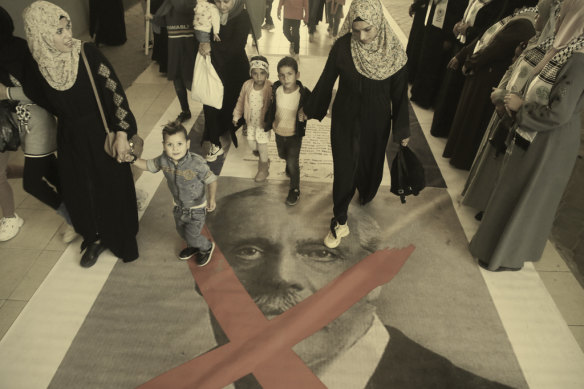
Palestinians walk over an image of former British prime minister Arthur Balfour during a protest in Gaza City in 2022. Credit: Getty Images, digitally tinted
From the outset, it was clear neither Britain nor France, depleted by war and loaded to the eyeballs with debt, had the resources to successfully control a large and diverse population that, post-Ottomans, had scant interest in being somebody else’s colonial prizes. Nationalism, religious friction and regional tensions flourished.
While every modern nation in the Arab region has had its own struggles, Egypt’s rocky path to independence is instructive. It took until 1956 to finally shrug off a monarchy and rid the country of colonial interference, following an anti-British revolution in 1952, led by a group of army officers that included the country’s future president, Gamal Abdel Nasser, and the Suez crisis. But there was another force at play in Egypt, too, which would go on to flavour some of today’s conflicts: the religious-nationalist group called the Muslim Brotherhood, which had first emerged in the 1920s and whose ideology would later inspire militant groups such as Islamic State and al-Qaeda.
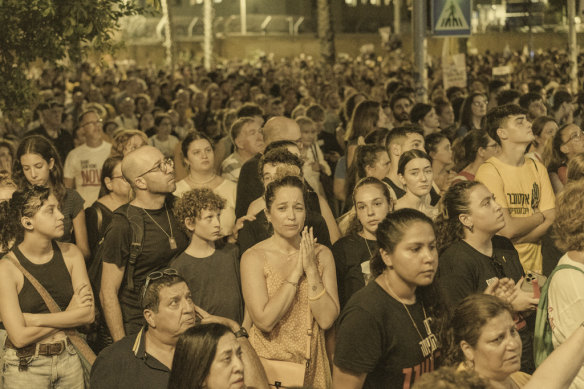
In Israel’s capital, Tel Aviv, supporters of Israelis held hostage in Gaza protest to demand their release 300 days after their abduction on October 7. Credit: Getty Images, digitally tinted
How might the current tensions play out?
Iran promised to inflict “harsh punishment” on Israel after the assassination of Haniyeh. But what form this will take is unclear. When Iran fired missiles at Israel in April, it gave 72 hours notice. There were no deaths and one reported injury. “It was done in a way to make sure that that almost certainly, they weren’t going to cause a major escalation,” notes Parmeter.
A worst-case scenario now could be a co-ordinated attack on Israel involving Hezbollah, Iran and the Houthis. “There would be some warning to Israel of missiles and lethal drones coming from countries further away than Lebanon. But it hasn’t happened,” Parmeter says. “And at this stage, the reason seems to be that Iran itself doesn’t want to get involved in what could be an all-out war with the US, if the US decides to become militarily involved on Israel’s behalf.”
‘To push Hezbollah north really won’t do much, given the weaponry they’ve got. They have missiles that could reach Tel Aviv if they chose to fire them at this point.’
ANU’s Ian Parmeter
Still, the issue Iran faces is that “the Supreme Leader loses face among people who look towards Iran for guidance if Iran doesn’t go ahead in some way”. Another possibility, Parmeter suspects, is a less overwhelming response such as a cyberattack that damages Israeli infrastructure or, if more bloodshed is the resort, an assassination overseas. Bowker agrees: “If they can find a means by which some damage can be done to the Israelis without basically getting into an open-ended escalation, they would prefer to do that.”
Meanwhile, as the evacuations continue on both sides of the Lebanon-Israel border, two far-right cabinet ministers in Israel’s government, Bezalel Smotrich and Itamar Ben-Gvir, have tried to pressure Israel’s Prime Minister, Benjamin Netanyahu, to invade southern Lebanon. Parmeter notes previous interventions in Lebanon have shown this “almost always ends badly” for Israel. “To push Hezbollah north really won’t do much, given the weaponry they’ve got. They have missiles that could reach Tel Aviv if they chose to fire them at this point.”
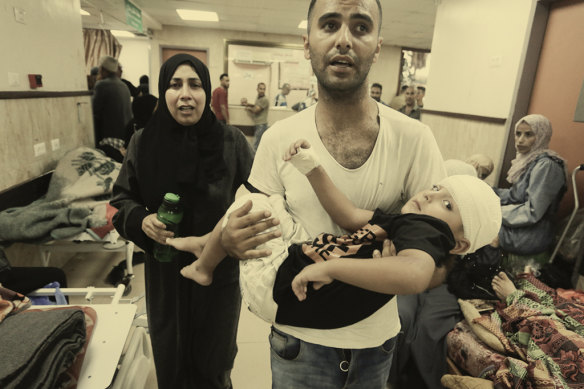
In Gaza, an injured child is carried through a hospital after an Israeli army bombing in August. Credit: Getty Images, digitally tinted
Iran has said it will hold back from retaliation if Israel agrees to a ceasefire deal for Gaza. Biden laid out a three-phase plan in May, beginning with an immediate ceasefire, release of hostages held by both sides, withdrawal of troops and the return of displaced Gazans to their homes, and ending with the reconstruction of Gaza. Contentious points have included the extent to which Israeli forces would remain in Gaza and at what point a ceasefire would become permanent.
Parmeter, who adds the caveat that “you never know everything” in the Middle East, says the assassination of Haniyeh, who had been Hamas’s chief negotiator, will likely affect these talks in Doha, which are being conducted by US, Qatari and Egyptian mediators. “Hamas’s hardline leader in Gaza, Yahya Sinwar, has now become the overall political head of the organisation, making negotiations even more difficult because he has to be reached in the tunnel network in Gaza by a Hamas courier,” says Parmeter.
‘The Israelis … have very little idea how they’re going to get out of this, and they would be very well advised to take the ceasefire deal that is on the table.’
Former Australian diplomat Bob Bowker
Shanahan is also pessimistic. “Netanyahu doesn’t appear to be interested in negotiations,” he says. Still, Bowker says Israel has few options. “I think that the Israelis, at the moment, have very little idea how they’re going to get out of this, and they would be very well advised to take the ceasefire deal that is on the table,” he says. Either way, Netanyahu’s stated outcomes of total destruction of Hamas and the unconditional release of hostages are “simply unrealistic”.
Loading
In the background, the shelved talk of normalisation between Israel and Saudi Arabia offers a glimpse of a potential future, says Parmeter. “If the Gaza War were to end, and essentially some sort of path to a future Palestinian settlement worked out as part of that – they are two pretty big ifs – quite probably, as part of that settlement, Saudi Arabia would be prepared to sign some sort of agreement with Israel,” he says. “A deal involving Israel and Saudi Arabia would, to the extent you can talk about this in the Middle East, be a match made in heaven because the Saudis have got the money, the Israelis have got the technology.”
Get fascinating insights and explanations on the world’s most perplexing topics. Sign up for our weekly Explainer newsletter.











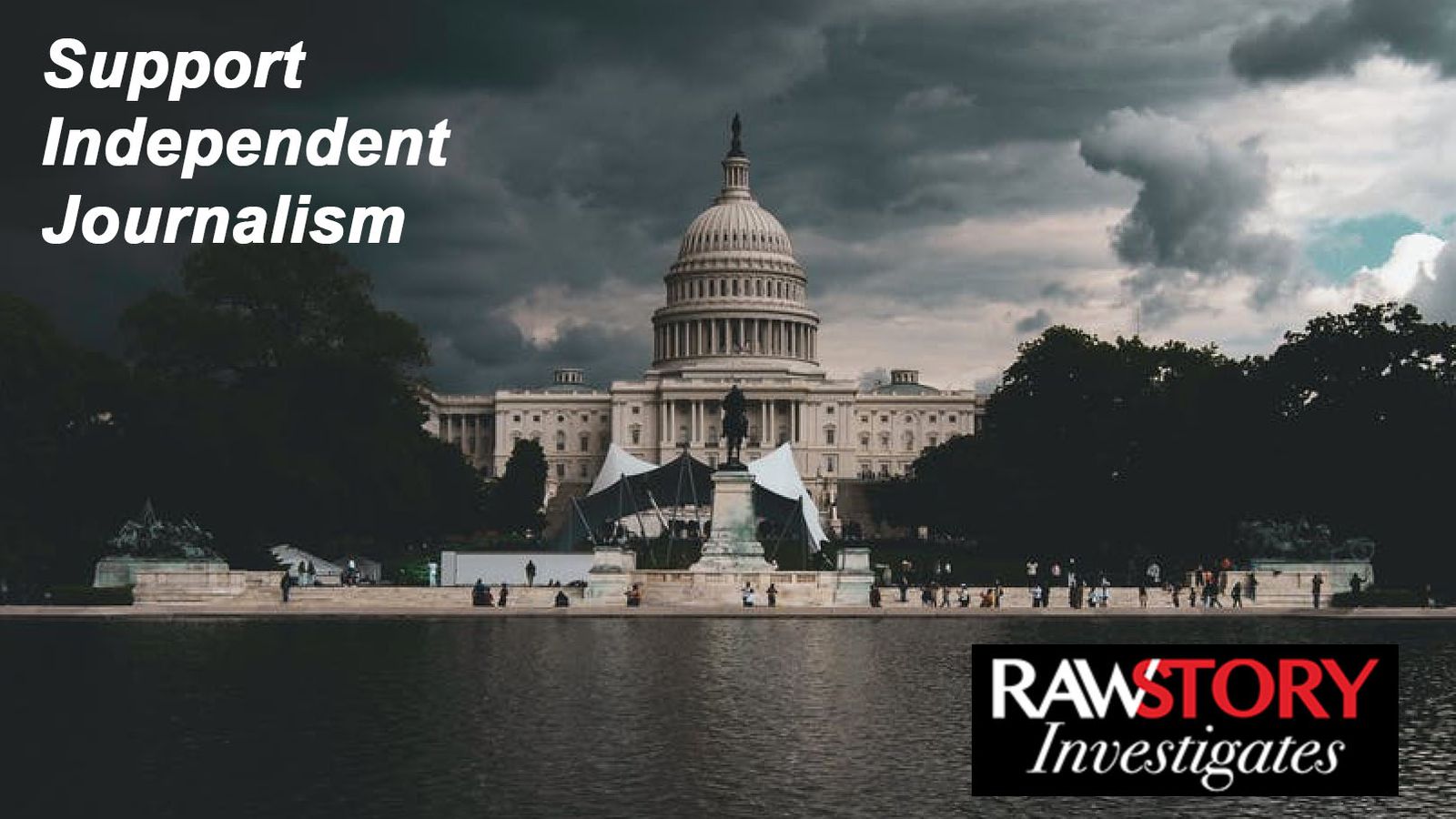

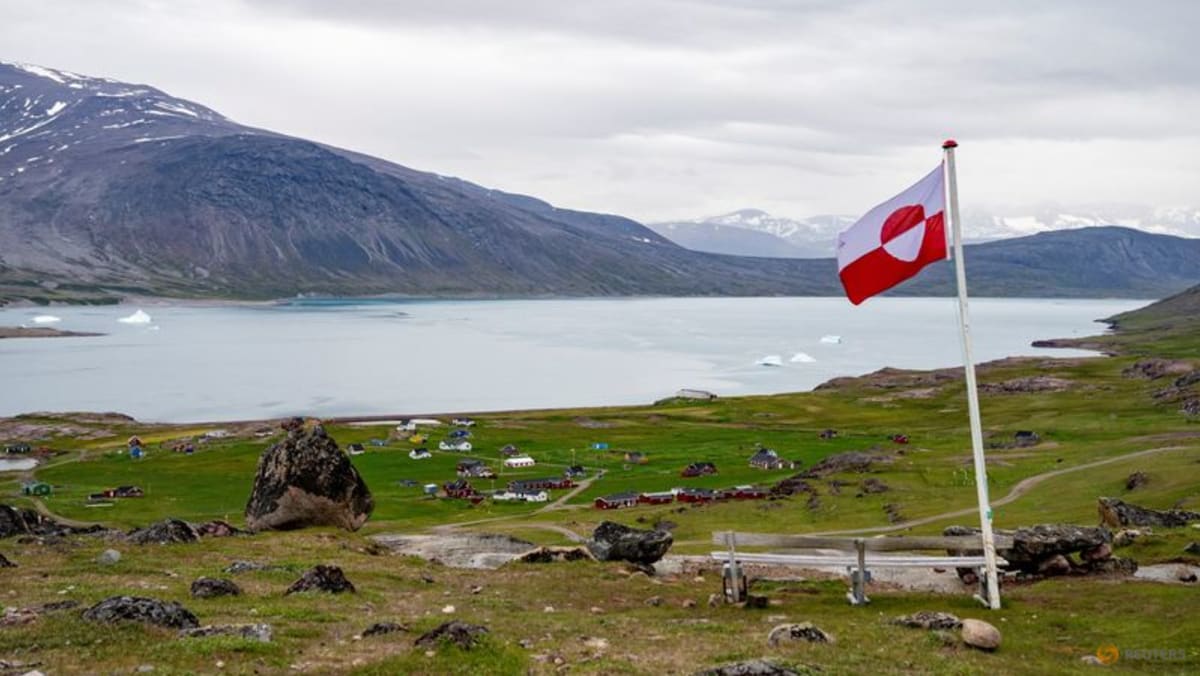







Discussion about this post